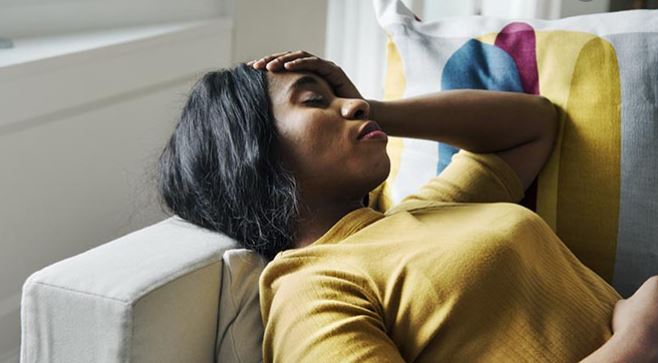
Headaches may have been a particular problem this year. In April 2020, there was a spike in Google searches for the tension variety, while a May survey by the Migraine Trust showed 58 per cent of sufferers reported theirs had been worse during lockdown.
This rise may have been connected to stress and a change in routine, including different diets and more alcohol – but we don’t tend to think about the cause. Instead, we take painkillers and hope they go away. But headaches can have different triggers and will often keep recurring unless you work out why you get them and change your behaviour.
The triggers
Vasodilation (the widening of blood vessels) in your head is often the critical issue – it’s what makes a headache manifest, whatever the specific cause. This is because your brain is your most vital organ and your body is sending you a warning sign your blood vessels are dilating. If this goes past a certain point, it could be dangerous and cause a haemorrhage.
The pain is a warning sign, which we often ignore by taking a painkiller to reduce the dilation – a strange thing to do, when you think of it like this. Under stress, we’re also likely to eat poorly and drink alcohol, which can contribute to headaches by dehydrating us.
Sinus headaches
The signs: Pain that starts in your face and gets worse when you lean forward. You may also get a stuffy or runny nose. These headaches happen due to blockages in your sinuses – four hollow cavities in the bones of your face – and are particularly common in teenagers as the sinuses haven’t fully developed yet.
What’s going on? You’ll get pain related to whichever sinus is blocked. Sometimes blockages can be due to allergies such as hay fever, and sometimes after an infection. The result is that blood floods the area with immune system chemicals including histamines, so you get vasodilation. You can take decongestants, paracetamol or ibuprofen as painkillers, and anti-inflammatories. Some people use menthol-based products inside their nose – the menthol activates the nose’s cool receptors so your brain thinks it’s less hot, meaning it takes its foot off the inflammatory pedal.
ALSO READ: Genetic and emotional links to migraines and the best ways of treating problem
Tension headaches
The signs: A tight band of pain across your forehead – your neck and shoulders may also feel tight, as though there’s a weight sitting on top of your head.
What’s going on? These are the most common types of headache, and can be a result of emotional or physical stressors. Physical stressors include being hunched up over your laptop or on the sofa. And if you’re under emotional stress, you’ll hold your body in a different way. Stress chemicals can prime your muscles to act, but you never expend this energy.
Either way, your autonomic nervous system – which governs processes like breathing, hunger and fluid balance – and your endocrine system, which controls hormones, are both at work, triggering inflammation. Lots more glucose and oxygen are sent to your brain, resulting in vasodilation again.
Cluster headaches
The signs: A severe headache on one side, with a bloodshot eye and running nose. One side of the face may droop. These headaches will crop up every so often.
What’s going on? We’re still learning more, but these seem to be connected to the hypothalamus – this part of the brain governs the endocrine system and the autonomic nervous system. The suprachiasmatic nucleus (SCN) in the hypothalamus is highly influenced by light that comes through your eyes, and controls your body clock through melatonin (which helps you sleep) and serotonin (the happy hormone). This may play a role in cluster headaches as they often seem to happen at the same time of year.
Levels of the hormone hypocretin which appears to regulate cravings, so people who have naturally lower levels of it than the rest of us tend to be the ones who are more likely to have addictive tendencies, are low in people with cluster headaches, one possible reason why people who get them are often heavy smokers. Raising serotonin through tablets or injections early in the episode can stop them.
ALSO READ: How to naturally get rid of headaches
Migraine
The signs: Migraines often start with yawning, blurred vision and thirst as your brain tries to regulate hormone imbalances. This is followed sometimes by an aura or visual distortions, then pain, possibly with nausea and light sensitivity, before the final phase where you may feel “out of it” as your brain’s neurotransmitters move back to where they should be.
What’s going on? Migraines are neurological – in other words, caused by activity in your brain. You get a wave of excitation, sometimes in response to a stimulus such as flashing lights or white shirts, sometimes for a physiological reason like a bump in estrogen at certain times of the month. This is quickly followed by a wave of no activity at all.
This pattern causes potassium to get trapped on the outside of the brain cells. It acts directly on pain receptors, constricting the brain’s blood vessels – then your brain starts to think it’s starving of nutrients so it kicks into gear and leads to massive vasodilation to compensate, causing pain.
 The Standard Group Plc is a multi-media organization with investments in media
platforms spanning newspaper print
operations, television, radio broadcasting, digital and online services. The
Standard Group is recognized as a
leading multi-media house in Kenya with a key influence in matters of national and
international interest.
The Standard Group Plc is a multi-media organization with investments in media
platforms spanning newspaper print
operations, television, radio broadcasting, digital and online services. The
Standard Group is recognized as a
leading multi-media house in Kenya with a key influence in matters of national and
international interest.



